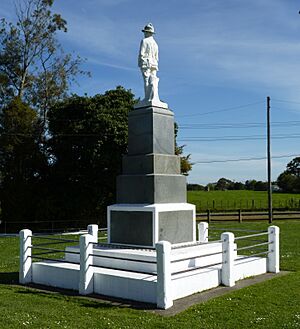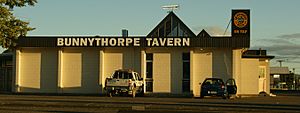Bunnythorpe facts for kids
Quick facts for kids
Bunnythorpe
|
|
|---|---|
|
village
|
|
| Country | New Zealand |
| Region | Manawatū-Whanganui region |
| Territorial authority | Palmerston North City |
| Ward |
|
| Named for | Henry Bunny |
| Electorates |
|
| Area | |
| • Total | 4.26 km2 (1.64 sq mi) |
| Population
(June 2023)
|
|
| • Total | 740 |
| • Density | 173.7/km2 (450/sq mi) |
| Area Code | 06 |
Bunnythorpe is a small village in the Manawatū-Whanganui region of New Zealand. It's located on the North Island, about 10 kilometres (6 miles) north of Palmerston North, a larger city. The area around Bunnythorpe is mostly covered by dairy farms. The village has a school, a rugby club, a country club, and a few factories. In 2018, about 687 people lived there.
Contents
Bunnythorpe's Story: A Look Back
The village of Bunnythorpe was created on land owned by the government. This land was divided up after the North Island Main Trunk Railway line was built through it. The village got its name from Henry Bunny. He was an important person who worked for the Wellington Provincial Council from 1853 to 1876.
There was once a plan to build another town called Mugby Junction right across the railway line. This was in 1878, and it was meant to be where the main railway line connected to the Napier line. However, the plans changed, and the railway junction was built in Palmerston North instead. So, Mugby Junction was never built.
Bunnythorpe is famous for being the birthplace of the Glaxo company. In 1904, a company called Joseph Nathan and Sons started a baby food factory here. They used local milk to make a special baby food called Glaxo. A popular saying in the 1930s was "Glaxo builds bonny babies." Even today, you can still see the old factory building on Bunnythorpe's main street. It has the original Glaxo logo on it. This factory dried and processed cow's milk into powder. Products were made here until 1973. The building is now owned by a business.
The Glaxo company grew into a huge pharmaceutical (medicine-making) company. After joining with other companies, it became part of GlaxoSmithKline in the United Kingdom in 2000. In 1979, the old Glaxo factory was changed into the Pantha BMX manufacturing plant. This was the first BMX bike factory in New Zealand. It was also home to the country's first BMX track!
The Bunnythorpe electrical substation was built in 1924. This station helped send electricity from the Mangahao Power Station to nearby towns. It soon became a major hub for electricity, with power lines going out to places like Napier-Hastings, Whanganui, and Masterton. Today, Transpower owns the substation. It is still a very important place for managing electricity in the lower-central North Island.
Where is Bunnythorpe?
Bunnythorpe is located between Palmerston North, the main city in the Manawatū region, and Feilding, its second-largest town. To the east of the village is Ashhurst, and to the west is Kairanga. Bunnythorpe is on the flat Manawatu Plains. There are only a few small rolling hills on the farms nearby. Several small streams flow through the town. The Mangaone Stream and Jack's Creek both flow southwest through Palmerston North. Other smaller waterways join these streams as they pass through the southern part of Bunnythorpe.
Who Lives in Bunnythorpe?
Statistics New Zealand calls Bunnythorpe a rural settlement. It covers about 4.26 square kilometres (1.64 square miles). In 2018, its population was 687 people. This means there were about 161 people living per square kilometre. Bunnythorpe is part of a larger area called Newbury.
| Historical population | ||
|---|---|---|
| Year | Pop. | ±% p.a. |
| 2006 | 645 | — |
| 2013 | 675 | +0.65% |
| 2018 | 687 | +0.35% |
At the 2018 New Zealand census, Bunnythorpe had 687 residents. This was a small increase of 12 people (1.8%) since the 2013 census. It was also an increase of 42 people (6.5%) since the 2006 census. There were 264 homes in the village. There were 342 males and 345 females. About 135 people (19.7%) were under 15 years old.
Most people in Bunnythorpe (90.4%) were of European/Pākehā background. About 17.5% were Māori. A smaller number were Pacific peoples (0.4%), Asian (2.6%), or other ethnicities (1.7%). Some people identify with more than one ethnic group.
When asked about their religious beliefs, 55.9% said they had no religion. About 33.2% were Christian. A small number followed Māori religious beliefs (0.9%), Hindu (0.4%), Muslim (0.9%), or other religions (1.3%).
Of the adults (15 years and older), 75 people (13.6%) had a university degree or higher. About 126 people (22.8%) did not have any formal school qualifications. Many people in Bunnythorpe were working. About 324 people (58.7%) had full-time jobs, and 72 people (13.0%) worked part-time.
Bunnythorpe's Weather
Bunnythorpe has a climate similar to Palmerston North. It's a temperate climate, meaning it has mild temperatures. However, Bunnythorpe can be a bit cooler. Winter temperatures (June to August) average around 11.2 degrees Celsius (52.2 degrees Fahrenheit). Summer temperatures (December to February) average around 20.6 degrees Celsius (69.1 degrees Fahrenheit).
Fun and Games in Bunnythorpe
Bunnythorpe is a safe and popular place for younger children. They often use the primary school's playgrounds and sports fields when school is not in session. There is also a Rugby Football Club on Raymond Street. This club has buildings and is also where the ANZAC memorial Cenotaph is located. The Mangaone Stream bridge, found off Maple Street on Te Ngaio Road, is a favourite spot for kids. They enjoy fishing for eels and fresh water trout there.
Getting Around Bunnythorpe
Road Travel
You can reach Bunnythorpe by road from several directions. Railway Road connects it to Palmerston North and Wellington in the south. The Ashhurst-Bunnythorpe Road comes from Ashhurst, Woodville, and Hawke’s Bay in the east. Kairanga Bunnythorpe Road leads from the west, and Campbell Road from the north, serving Feilding.
Air Travel
Bunnythorpe is very close to Palmerston North Airport. It's less than a 10-minute drive away. From this airport, you can catch regular flights to major New Zealand cities like Auckland, Wellington, Hamilton, Christchurch, and Nelson.
Train Travel
The North Island Main Trunk Railway line runs right through the middle of Bunnythorpe. However, trains no longer stop at the station. The station closed in 1985. Freight and passenger trains still travel on this line between Wellington and Auckland. If you want to catch a passenger train, you need to go to Palmerston North.
Bus Travel
A bus service runs every hour between Feilding and Palmerston North, and it stops in Bunnythorpe. The main bus stop in Palmerston North is on Main Street. This is also where you can catch buses to other parts of Palmerston North. For longer trips between cities, you can find Inter-City buses departing from Palmerston North.
Learning in Bunnythorpe
Bunnythorpe School is a public primary school for students in Year 1 to Year 8. It teaches both boys and girls. As of 2023, about 22 students attend the school.




